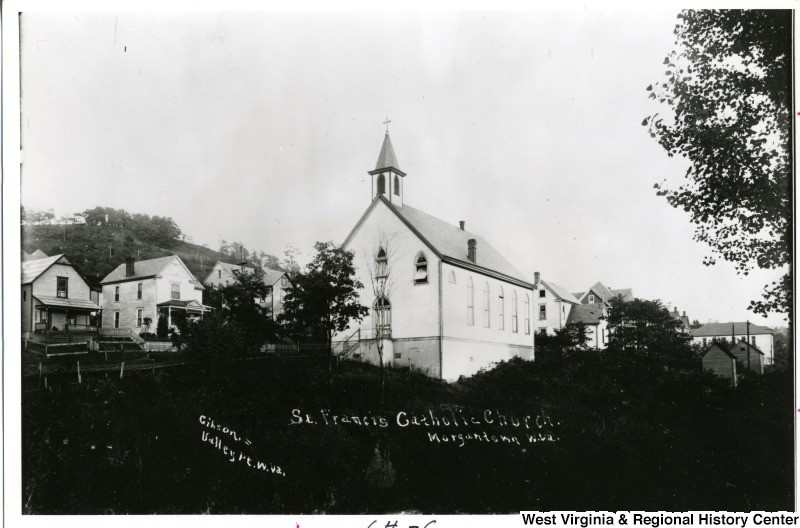St. Francis de Sales Catholic Church (1898-1924)
Introduction
Text-to-speech Audio
Images
A view of St. Francis de Sales in Sunnyside, built in 1898. West Virginia and Regional History Center, WVU Libraries.

Portrait of Father Kluser. West Virginia and Regional History Center, WVU Libraries.

Backstory and Context
Text-to-speech Audio
In 1897, Mrs. Joseph Stenger, a Seneca resident who sensed the need for a physical space to anchor the local Catholic community, wrote a letter to the Bishop of Wheeling asking that a church be built.1 That letter began the process of constructing the future St. Francis de Sales church, a building that would be the first Catholic place of worship in Monongalia County.
The Catholic community of Sunnyside began as a small percentage of the mostly Protestant local population. The arrival of glass factories brought new faces into the small town, many of whom were European immigrants. Eager to maintain their connections to their faith and cultural customs, these immigrants desired to continue to receive the sacraments and worship together as a community. To meet their needs, services were initially held in the homes of residents, conducted by visiting priests.2
The Catholics of Sunnyside yearned for a church and priest of their own and firmly believed that they could support their own parish. To prove this point to the Bishop of the Diocese of Wheeling, a committee was formed to solicit a subscription from each local Catholic family. Seeing the eagerness and financial ability of the Sunnyside Catholics and their rapidly increasing numbers, Bishop Donahue agreed to the proposal. Bishop Donahue purchased the land for the new parish in 1897 from the Morgantown Building and Investment Company. The church building was completed within a year of the purchase. On Sunday, July 17, 1898, at nine o’clock in the morning, a special Mass was held to dedicate and bless the new building. Bishop Donahue presided over the ceremony, which was attended by hundreds of local community members. By the end of 1901, Fr. Charles Joseph Kluser, an immigrant from Switzerland, had been appointed the first permanent pastor. The church sat almost directly in the center of the neighborhood and within sight of the industries along the Monongahela River. Many of St. Francis’s most active parishioners, many of whom were working class European immigrants, lived within easy walking distance of the church.3
St. Francis de Sales was simple and practical in design. The rectangular wood-frame building was constructed in the Carpenter Gothic style, with plain white wooden siding and large stained glass windows topped with pointed arches. A simple steeple rose from the gabled roof, adding prominence to the building perched on the side of a hill. Church records indicate that the interior was carpeted and housed an organ. The building may have lacked the grandeur of a medieval cathedral, but it was a practical and welcome space.4
The congregation eventually outgrew the building and in 1924 relocated to a larger space on Beechurst Avenue. Today, there are several Catholic churches in Morgantown, including St. Frances de Sales which is south of Morgantown on Route 119. Though the original St. Francis no longer exists, it was a crucial part of the early development of Morgantown's Catholic community and an equally important component of the story of the Sunnyside neighborhood.
Sources
1. Frau Joseph Stenger, Mrs. Joseph Stenger to Bishop Donahue, March 21, 1897, Letter, from the Archives of the Diocese of Wheeling-Charleston.
2. Earl L. Core, The Monongalia Story: A Bicentennial History, Volume IV: Industrialization (Parsons, WV: McClain Printing Company, 1982), 45, 233-234; The Church Calendar, “Morgantown,” April-May 1921, microfilm, from the Archives of the Diocese of Wheeling Charleston.; Church of Saint Teresa of the Child Jesus: Souvenir of Dedication, November 26, 1939, ephemera, from the Archives of the Diocese of Wheeling-Charleston.
3. Core, Volume IV, 273; Deed of Sale, The Morgantown Building and Investment Company to P.J. Donahue, July 31, 1897, Monongalia County, West Virginia, Book 45, p. 346, Office of the County Clerk, Morgantown, WV; The Daily New Dominion, “The Catholic Church,” July 16, 1898, microfilm, from the West Virginia and Regional History Center.
4. Sanborn Map Company, Morgantown, Monongalia County, West Virginia: Oct. 1906, 50ft=1inch, Fire Insurance Maps for West Virginia, West Virginia and Regional History Center; Rev. Peter Flynn, St. Francis de Sales Annual Report: Financial Statement, 1915, from the Archives of the Diocese of Wheeling Charleston.
Images:
“St. Francis Catholic Church, Morgantown, W. Va.” Photo. West Virginia and Regional History Center at West Virginia University Libraries. West Virginia History OnView. Accessed January 2018. http://wvhistoryonview.org/catalog/wvulibraries:11759
“Portrait of Father Kluser.” Photo. West Virginia and Regional History Center at West Virginia University Libraries. West Virginia History OnView. Accessed January 2018. http://wvhistoryonview.org/catalog/wvulibraries:36371
Research compiled by Kara Gordon. Edited by Elizabeth
Satterfield and Pamela Curtin.
